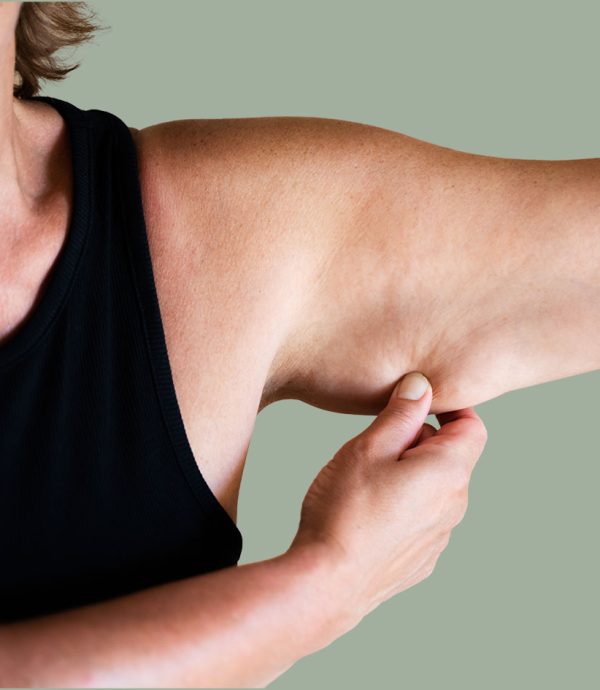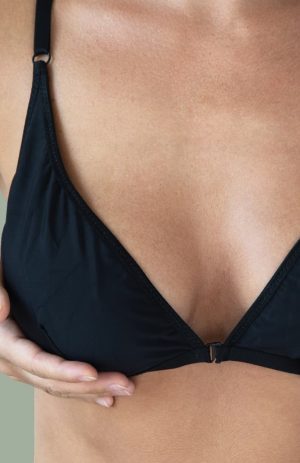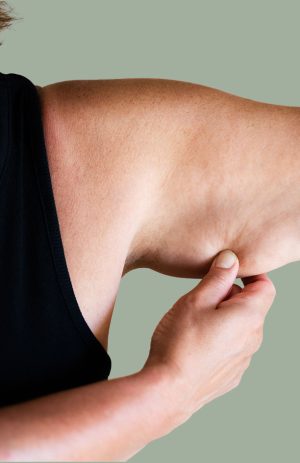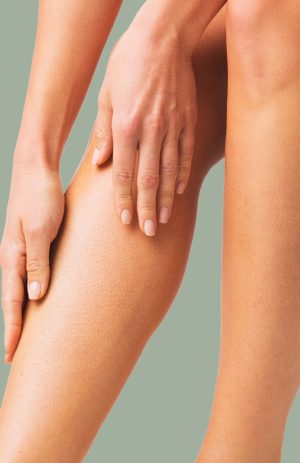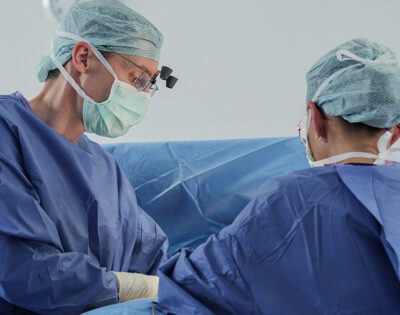Firm and shapely upper arms in Saarbrücken
Severe weight loss or a genetic predisposition can cause the skin on the upper arms to sag. The loss of elasticity and reduction in the skin’s ability to tighten causes unsightly excess skin to form – usually on the inner sides of the upper arms. Sport can’t help here either. The sagging of the tissue, which is perceived as unsightly, restricts the quality of life and self-esteem of many sufferers, resulting in a desire for firm and shapely upper arms.
What our patients say
Information at a glance
Operation duration
2 hours
Aftercare
6 weeks
Anesthesia
Twilight sleep
Thread tension
Self-dissolving threads
Hospitalization
Outpatient
Socially acceptable
after 5 days
Costs
Additions or alternatives
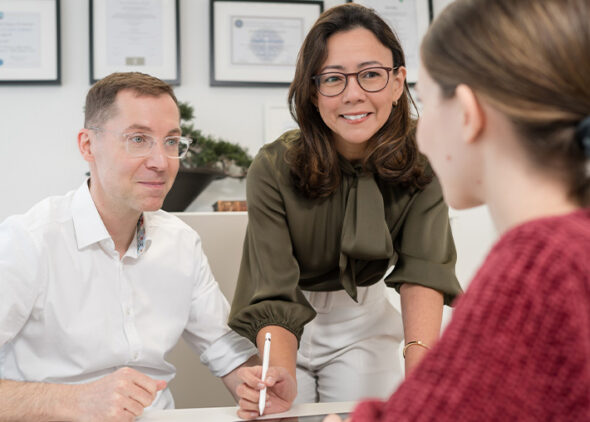
What is an upper arm lift?
During a tightening operation, excess and sagging tissue is removed. In order to tighten the tissue as gently and evenly as possible, the subcutaneous fatty tissue is suctioned out. The contours become slimmer and the skin firmer. The scars from an arm lift are hidden on the inside of the upper arm.
Fat tissue on the upper arms is preferentially metabolized during frequent weight fluctuations 1 . If the elasticity of the skin and supporting tissue decreases as a result of weight loss or increasing age, sagging excess skin remains. This can result in misshapen upper arms and restricted movement. The sagging skin wobbles with every movement. Angular arms often cause a high level of psychological distress 2 . The shape, contours and proportions of the upper arm can be improved with an upper arm lift, also known as brachioplasty. Arm lifts have been performed since 1930 and have been continuously developed since then 3 . Around 170,000 upper arm lifts were performed worldwide in 2018 4 . Ninety percent of upper arm lifts are performed on women, usually around the age of forty 5 .
Procedure for an upper arm lift

Preparation
- All questions about possible complications and alternative treatment methods should be answered in advance.
- Nicotine and alcohol consumption should be kept to a minimum!
- It may be necessary to take hormone-containing medication (the pill). temporarily.
- Blood-thinning medication (e.g. ASS, Thomapyrin®) must be taken at least once a week. 10 days before the cosmetic surgery (after consultation with your doctor).
- Vitamin preparations (A & E) and food supplements (omega-3 fatty acids or St. John’s wort preparations, etc.) must be taken at least once a week. 4 weeks before the operation.
- Surgeries restrict your ability to travel by air. You should therefore not plan any air travel in the 6 weeks following the procedure, either for business or pleasure!
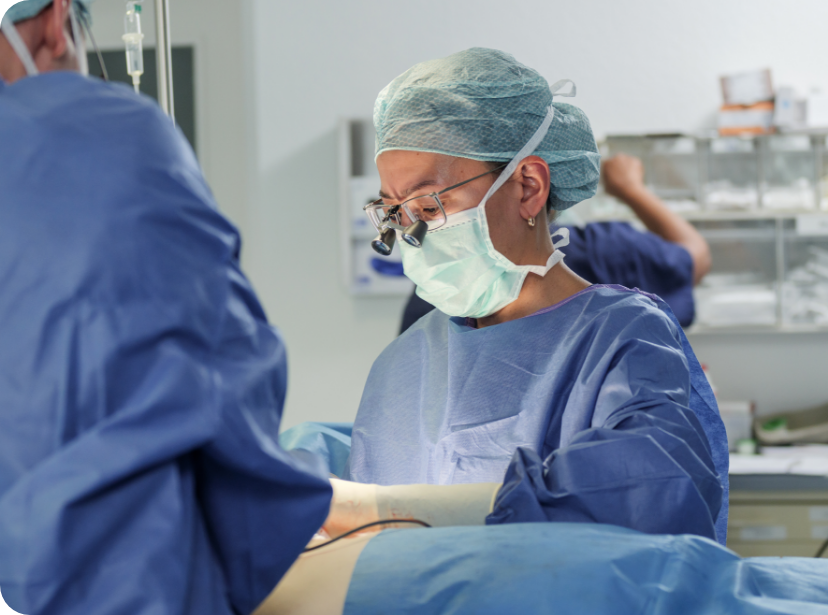
The OP
On the day of the operation, you will be met by your surgeon after you have checked in. This is followed by a routine check-up before your doctor transfers the surgical plan to the skin with a special pen. The anesthetist will then greet you and check all the safety precautions again. You will then be accompanied to the operating room of the clinic or, in our case, the operating room of the practice, where the entire surgical team will be ready for you.
While you listen to some music to relax, the team starts with the final preparations. After you have fallen asleep, the upper arm is anesthetized and the surgical procedure begins. Following the surgical upper arm lift, you will be able to rest and, after a short time, have something to drink and eat. You can be picked up approximately two hours after the aesthetic procedure. Your surgeon will discuss the course of the operation with you beforehand and behavioral instructions that should be observed in the following days. If necessary, your doctor can also be contacted by telephone. You will be offered four to six appointments to monitor the healing process.
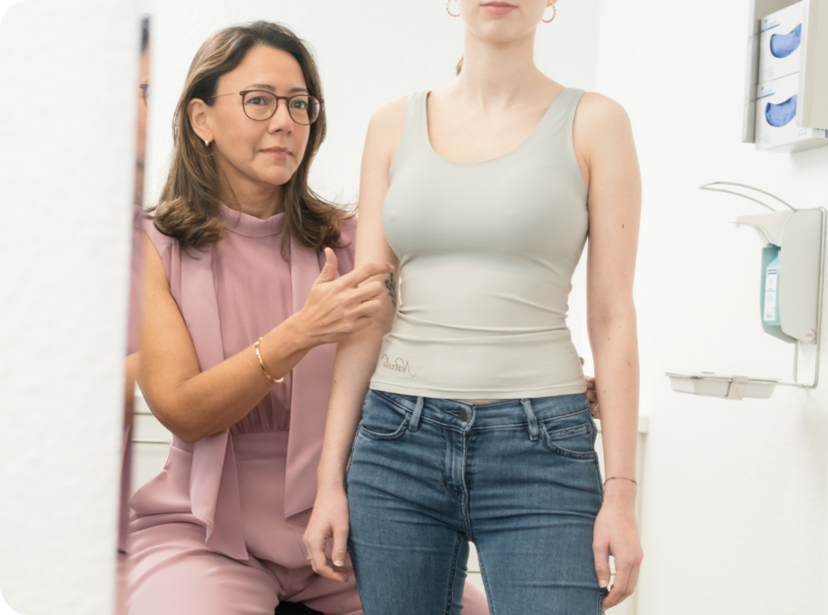
After the procedure
Even an optimally performed operation requires good aftercare in order to achieve a perfect result. There are only a few things you need to bear in mind so that you can relax after the operation and look forward to a good result:
- Healing after the operation takes about ten to fourteen days. During this time, your doctor should inspect the wound two to three times.
- You can shower as early as the third day after the operation. We recommend that you shower in the morning before your surgery appointment so that the wound can be re-dressed afterwards. Remove the plaster before showering. No soap residue should remain after showering. Then dry your arms with a fresh towel and apply a new plaster.
- The stitches dissolve by themselves and do not need to be removed.
- Massaging the scar with a fat cream from the third week onwards supports scar healing. This makes the scars particularly inconspicuous.
- Avoid vigorous or enduring physical activity through sports or heavy work during the first four weeks.
- Wearing a special tight-fitting shirt, also known as a compression girdle, prevents swelling from developing. We recommend wearing the compression girdle for four to six weeks, depending on the degree of swelling.
Surgical techniques for upper arm lift
Choosing the right surgical technique is the key to a successful result. Which of the surgical techniques is appropriate depends on the size of the sagging skin flap and the amount of fatty tissue. The skin elasticity and the extent of the desired tightening and circumference reduction are also decisive. This means that either the removal of excess skin or liposuction or a combination of both procedures may be indicated. The removal of excess skin from the entire upper arm is accompanied by a scar that is very inconspicuous if the surgeon plans carefully. Skin tightening techniques differ in terms of the length, location and course of the scar. Previous techniques have left visible scars on the back or inside of the upper arm, which were visible from the front or back depending on the viewing angle 6 . Feedback from our patients and scientific studies show that a scar between the inside and the back of the upper arm is barely noticeable 7 .
Liposuction of the upper arm: Gentle and targeted liposuction of the upper arm has become an indispensable part of every upper arm lift 8 . In young patients, liposuction may be sufficient to contour the upper arms, as excess skin will partially disappear. Depending on the amount of excess skin and skin elasticity, additional liposuction can be used to perform a particularly scar-saving operation. Vibratory liposuction (SAFE Lipo) has proven to be effective in protecting the lymphatic vessels and nerves.
Scar-saving I-technique:
In young patients with good skin elasticity, the particularly scar-saving I technique can be used. Ideally, there is only a moderate increase in circumference. The excess skin should be limited to the upper arm close to the body. In these cases, the scar is limited to the armpit and is not visible even in a bikini 9 .
Scar-saving mini-T technique:
If the excess skin mainly affects the upper arm close to the body, a tightening is possible with a short scar that is not visible in a T-shirt or short-sleeved or sleeveless clothing. For the greatest possible tightening effect, we combine this technique with a skin tightening along the axillary fold. This allows the greatest possible tightening effect to be achieved with a small and barely visible T-shaped scar.
T-shaped upper arm lift:
This technique is suitable for removing pronounced excess skin on the upper arm. The technique was first described in 1979 10 . In order to achieve more inconspicuous scars, the technique has been further developed and combined with liposuction 11 .
L-shaped upper arm lift:
This technique involves a combination of an upper arm lift and a lift of the lateral chest below the armpits. The scar runs in an L-shape from the underside of the upper arm to the side of the chest. This technique was first described by the Brazilian plastic surgeon Pitanguy in 1975 12 . Further developments of this technique and the combination with liposuction result in inconspicuous scars 13 .
Z-shaped upper arm lift:
The technique describes the interruption of a straight wound course in the armpit with a Z-pattern so as not to impair arm mobility. This technique is only used if excess skin is removed from the upper arm and also from the side of the chest. Z-plasty is a widely used plastic surgery technique that was described as early as 1837 and its use in upper arm lifts was first mentioned in 1979 14 15 .
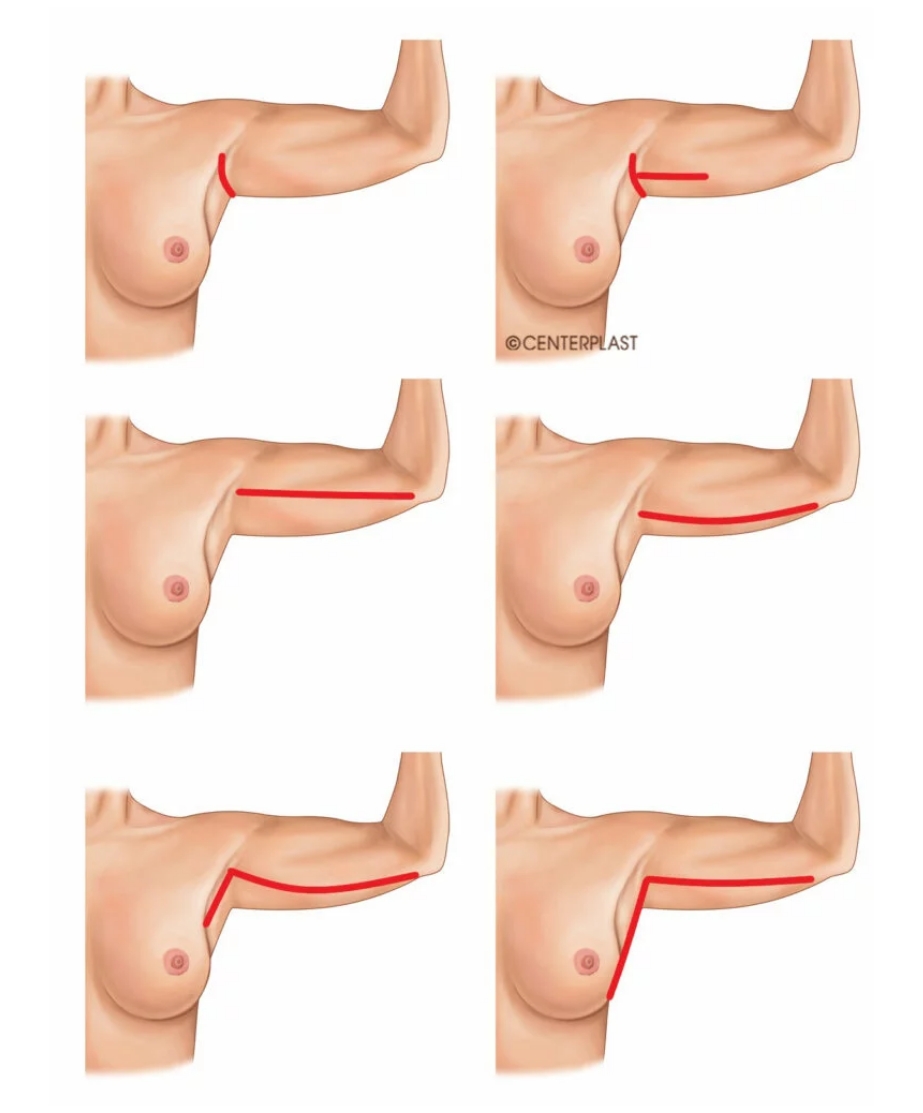
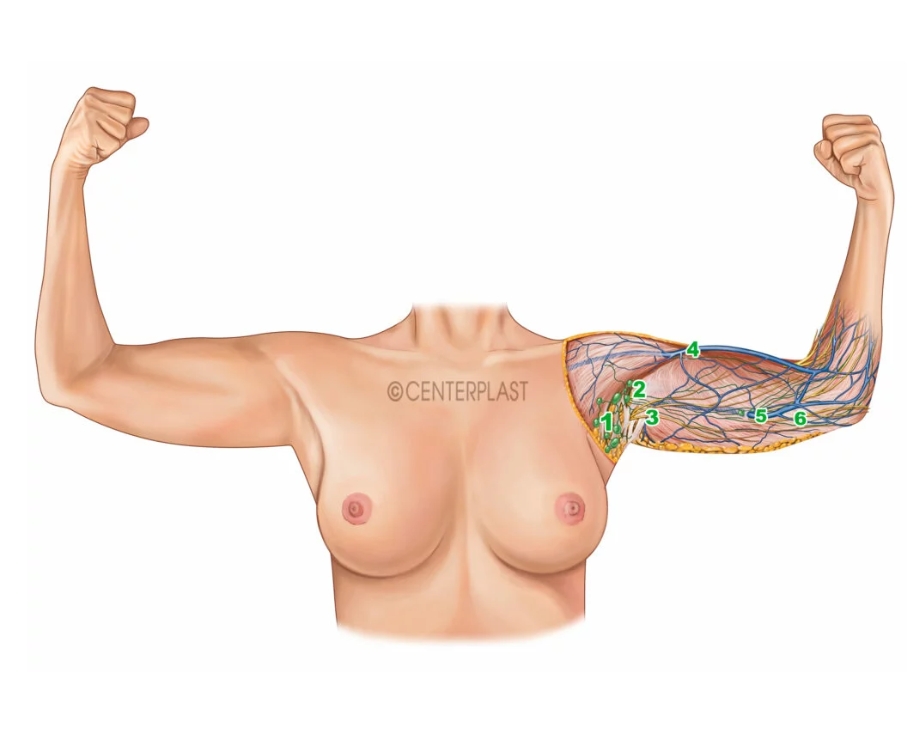
The upper arm lift removes unwanted sagging skin on the upper lobe. Different tightening techniques can be used depending on your needs: the scar-saving I-technique, the scar-saving mini-T-technique and the T-, L- or Z-shaped upper arm lift. If necessary, fatty tissue is suctioned out at the same time to achieve slimmer contours.
1 . lymph nodes of the armpit 2 . lymph vessels of the upper arm 3. cutaneous nerves of the inner side of the upper arm (nervus cutaneus brachii medialis) 4. main vein of the upper arm (vena cephalica) 5. vein of the inner side of the upper arm (vena basilica) 6. cutaneous nerves of the inner side of the forearm (nervus cutaneus antebrachii medialis)
The upper arm lift removes unwanted sagging skin on the upper lobe. Different tightening techniques can be used depending on your needs: the scar-saving I-technique, the scar-saving mini-T-technique and the T-, L- or Z-shaped upper arm lift. If necessary, fatty tissue is suctioned out at the same time to achieve slimmer contours.
Stage1: Mini upper arm lift with liposuction
Stage 2a: Mini T-upper arm lift with liposuction
Stage 2b: Upper arm lift
Stage 3: Upper arm lift and lift under the armpit
Stage 4: Upper arm lift and tightening of the lateral upper body
1. region of excess skin that is removed during a mini upper arm lift. 2. region of excess skin that is removed during a mini T-arm lift. 3. region of excess skin that is removed during an upper arm lift. 4. region of excess skin that is removed during an upper arm lift and a lift under the armpit. 5. Region of excess skin that is removed during an upper arm lift and lateral torso lift.
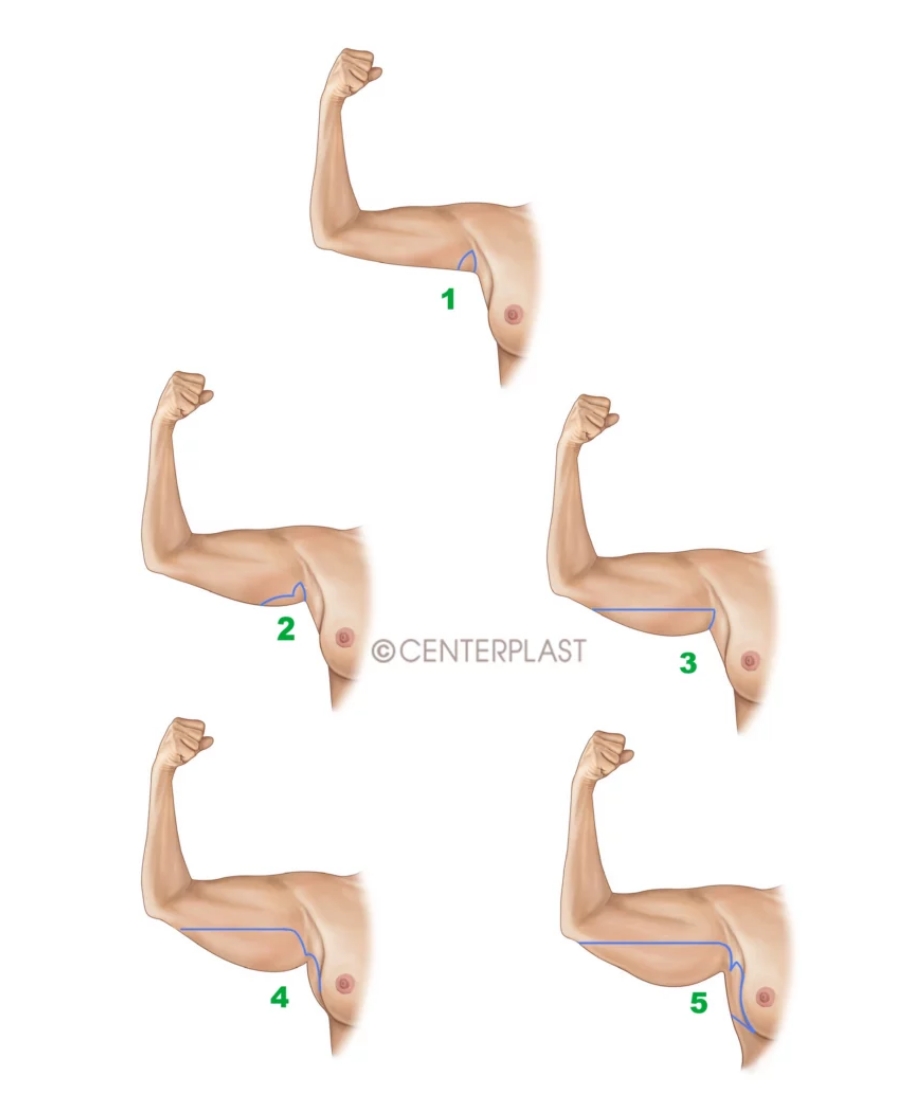
Upper arm lift without surgery
More and more people are succeeding in shedding unhealthy lifestyles and achieving a healthy body weight. Accordingly, there is a steadily growing demand for upper arm lifts. Thanks to modern and gentle procedures, outpatient surgical skin tightening of the upper arms is usually less painful than laser or ultrasound treatment. Nevertheless, the prospect of tightening the upper arms without surgery is tempting. There are plenty of advertising promises for firm or slim arms. But what can alternative treatments really do?
| Procedure | Principle | Experience | Results |
| CO2 laser | Lasers transmit energy in the form of light. When a laser hits tissue, it generates a lot of heat and burns. The body’s repair processes stimulate collagen production, which smoothes fine wrinkles. | The CO2 laser has been used to improve the appearance of the skin since 1989.16 | Laser collagen stimulation is neither suitable for tightening the face nor for tightening sagging skin on the upper arms. |
| Laser lipolysis (SlimLipo™) | Lasers can be used on fatty tissue as part of a liposuction procedure. Fatty tissue is melted down through the development of heat. | Lasers have been used in conjunction with liposuction since 1992.17 | The technology harbors a risk of internal combustion. However, the technique is not suitable for noticeably tightening the skin 18 19 . |
| Thread lifting | The barbs of the thread lift sutures move the subcutaneous fatty tissue by a few millimeters. In addition, local collagen formation occurs when the synthetic material is broken down. | Sutures made from the absorbable material PDO (polydioxanone) have been used in plastic surgery for suturing wounds since 1983.20 | There is currently no scientific evidence to support the use of PDO threads for tightening the upper arms. |
| Radio frequency | The high-frequency alternating current of radio frequency technology generates heat. Similar to laser technology, radiofrequency technology can also be used in liposuction. | Radiofrequency technology has been used in surgery to stop bleeding since 1940 21 . | The upper arm lift with radiofrequency technology has a higher complication rate with comparable results.22 |
| Ultrasound (Ultherapy®) | Focused high-intensity ultrasound (HIFU) uses heat to destroy the tissue. | HIFU technology was first used to treat nerve diseases in 1960 23 . | The reports of a few individual cases after Ulthera treatments are encouraging but cannot be compared with the effect of an upper arm lift.24 |
| Cryolipolysis | During cryolipolysis, the body tissue is cooled to between four and ten degrees. The cooling of a circumscribed body surface leads to the destruction of fat cells. | The technique has been used since 2009 and leads to a slight reduction in fatty tissue in small, circumscribed areas of the body. | Cryolipolysis is not expected to have a firming effect. |
| Fat-away syringe | Deoxycholic acid dissolves the cell wall and thus destroys the fat cells. | Kybella™, also known as deoxycholic acid or ATX-101, has been approved in the USA since 2015 but not in Europe. Fat removal injections, also known as injection lipolysis, are suitable for correcting small fat deposits, such as sagging cheeks. | Both the risks and the costs are disproportionate when attempting to treat the upper arms. The fat removal injection does not have a skin-tightening effect. |
| Sport | Dumbbell exercises, terraband exercises and EMS (electro-myo-stimulation) go hand in hand with fat burning. | Sport has countless positive and health-promoting properties. | However, there is no scientific evidence for a skin-tightening effect. |
| Hyaluronic acid, creams | Daily skin care with moisturizing and moisturizing lotions prevents skin damage. | Oils and fats for skin care were already used by the ancient Egyptians 25 . | Despite intensive research, neither drugs nor medical devices currently have any proven value in the treatment of angle arms. |
Experience reports of an upper arm lift
Reading reviews of surgeons and medical practices in general on so-called medical review portals can help patients find a good doctor for the treatment they want. In addition, there are also reviews or testimonials on Google or other websites on the Internet that can round off the picture. Make sure that there are sufficient contributions so that you can expect a realistic average overall picture of the experience and professionalism of the doctors treating you. Based on your impressions, experiences and feedback on the final results, you can choose the right plastic and aesthetic surgeon to plan your cosmetic surgery without fear and be sure of a good result.
What are the risks of an upper arm lift?
Surgical methods and anesthetic procedures are becoming increasingly safe. Nevertheless, every treatment also harbors potential risks. The patient’s state of health and lifestyle have an impact on the risks. It is therefore to be expected that the risks in healthy non-smokers are lower than the following average values:
- Wound healing disorder: 3.1 percent.
- Wound water accumulation (seroma): 3.0 percent.
- Water retention (lymphoedema): 1.6 percent.
- Nerve injuries: 1.5 percent 26 .
Gentle liposuction, wearing a compression garment and physical rest during the first week counteract the risks of wound fluid accumulation or lymphoedema. In the vast majority of cases, the symptoms resulting from the complications mentioned above improve on their own. Follow-up surgery is required in only 1.6 percent of cases 27 .
Upper arm lift together with a tummy tuck, thigh lift or breast lift?
People who have achieved their goal of losing a lot of weight often suffer from the sight of sagging skin. As a rule, several areas of the body are affected, such as the upper arms, thighs, abdomen and breasts. Aesthetic plastic surgery techniques help to create firmer body contours. The combination of several tightening operations is also known as a body lift. The combination of a tummy, breast, arm and leg lift in one operation is associated with avoidable risks. Both the state of health and the amount of surgery involved have an impact on the risks. It should therefore always be decided on an individual basis how many and which aesthetic surgery treatments should be combined in one procedure.
FAQ – Frequently asked questions
Would you like to know the price of an upper arm lift? If you have any questions, you can contact us at any time by phone or e-mail or simply book your personal consultation via our online appointment system.
Weight fluctuations can lead to sagging skin on the upper arms in both men and women. If the skin and fatty tissue hang limply when the upper arm is held up, this is colloquially referred to as an angular arm. The amount of fatty tissue in the upper arms varies depending on body type. The extent of excess skin can be classified according to the size of the hanging skin flap 28 . After severe weight loss, the skin sags more than ten centimeters below the upper arm.
An upper arm lift or liposuction of the upper arms is not usually covered by health insurance. A rare exception is the pathological fat distribution disorder, also known as Madelung lipomatosis or Launois-Bensaude syndrome. This leads to fat deposits, usually on the neck, shoulders and upper arms. The disease occurs predominantly in Europe in men between the ages of 45 and 65. 29
In our menu under “Costs” you will find a special section on financing options. Here we provide valuable tips and advice on how you can finance your cosmetic surgery on your arms. We would also be happy to advise you in a personal consultation on the subject of financing cosmetic surgery.
Every patient is different. Therefore, there is no universal solution in medicine. Modern anesthesia offers many procedures to ensure your comfort and freedom from pain. Two common procedures are twilight sleep and general anesthesia.
Unlike general anesthesia, twilight sleep does not require artificial respiration. However, artificial respiration is not a prerequisite for an upper arm lift without pain. Twilight sleep in combination with a local anesthetic (local anesthesia) is very gentle, has few side effects and is safe. The long-acting anesthetic ensures rapid recovery and a high level of comfort. Both the aesthetic surgeons and the anesthesiologist will be happy to advise you.
Patients are increasingly searching the Internet for surgeons abroad (e.g. Poland, Turkey, Holland or Austria) who perform cosmetic surgery such as an upper arm lift. The main reason for this is the cost. Foreign facilities are increasingly attracting unsuspecting patients via social media. They advertise with promises and high discounts, a practice that would be punishable in Germany. We advise you to obtain detailed information about the experience and training of the surgeons. As a rule, these important criteria are not or only briefly dealt with on the websites. Unfortunately, there are often complications due to a lack of qualifications. In retrospect, they sometimes rename themselves to cover their tracks.30
It is therefore essential that you find out in detail about the practice and the surgeon you are entrusting yourself to.

AUTHOR
Dr. Stéphane Stahl
We provide you with extensive expert knowledge in order to select the best possible treatment path together with you.
Privatdozent Dr. med. Stéphane Stahl is the former Director of the Clinic for Plastic, Reconstructive and Aesthetic Surgery / Hand Surgery at Lüdenscheid Hospital. Dr. Stahl studied medicine at the Universities of Freiburg and Berlin.
He passed the European specialist examination for plastic and aesthetic surgery in 2011 and the German specialist examination in 2012. This was followed by further specialist qualifications and additional qualifications (including quality management, medical didactics, physical therapy, emergency medicine, laser protection officer, hand surgery) as well as prizes and awards.
In 2015, he completed his habilitation in plastic and aesthetic surgery in Tübingen. He is an experienced microsurgeon, sought-after expert witness and regular speaker at specialist congresses. Following a multi-stage selection process, Stéphane Stahl became a member of the American Society for Aesthetic Plastic Surgery (ASAPS), one of the world’s largest and most influential specialist societies for aesthetic surgery.
His authorship includes numerous articles in prestigious peer review journals and standard surgical textbooks.
- El Ghoch M., Milanese C., Calugi S., et al., 2015, Clin Nutr. ↩︎
- Ibrahim A.M., Sinno H.H., et al., 2014, Ann Plast Surg. ↩︎
- Thorek M., 1930, Illinois Medical Journal ↩︎
- ISAPS Statistics 2018 ↩︎
- Nguyen L., Gupta V., Afshari A., et al. 2016, Aesthet Surg J. ↩︎
- Hurwitz D.J., Holland S.W., 2006, Plast Reconstr Surg. ↩︎
- Simone P, Carusi C, Segreto F, et al., 2018, Plast Reconstr Surg. ↩︎
- Vogt P.A., 2001, Aesthet Surg J. ↩︎
- Rohrich RJ, Mohan R, et al., 2020, Plast Reconstr Surg. ↩︎
- Juri J, Juri C, Elías JC., 1979, Plast Reconstr Surg. ↩︎
- Lockwood, T. Brachioplasty with superficial fascial system suspension. Plast. Reconstr. Surg. 96: 912, 1995. ↩︎
- Pitanguy, I., 1975, Clin. Plast. Surg. ↩︎
- Hurwitz D.J., Holland S.W., 2006, Plast Reconstr Surg. ↩︎
- Horner, W.E., 1837, American Journal of Medical Science ↩︎
- Guerrero-Santos, 1979, Aesthetic Plast. Surg. ↩︎
- David LM, Lask GP, Glassberg E, et al., 1989, Cutis. ↩︎
- Apfelberg D., 1992, Clin Laser Mon. ↩︎
- Leclère F.M., Alcolea J.M., Vogt P.M., et al., 2016, Plast Surg ↩︎
- Pereira-Netto D., Montano-Pedroso J.C., et al., 2018, Aesthetic Plast Surg. ↩︎
- Chusak R.B., Dibbell D.G., 1983, Plast Reconstr Surg. ↩︎
- Massarweh N.N., Cosgriff N., Slakey D.P., 2006, J Am Coll Surg. ↩︎
- Chia C.T., Theodorou S.J., Hoyos A.E., et al., 2015, Plast Reconstr Surg Glob Open. ↩︎
- ter Haar G., Coussios C., 2007, Int J Hyperthermia ↩︎
- Asiran Serdar Z, Tukenmez Demirci G., 2020, J Cosmet Dermatol. 2020 ↩︎
- Lucas A., 1930, J Egypt Archaeol. ↩︎
- Aljerian A., Abi-Rafeh J., Ramirez-Garcia Luna J., et al., 2022, Plast Reconstr Surg. ↩︎
- Aljerian A., Abi-Rafeh J., Ramirez-GarciaLuna J., et al., 2022, Plast Reconstr Surg. ↩︎
- Teimourian B, Malekzadeh S., 1998, Plast Reconstr Surg ↩︎
- Liu Q., Lyu H., Xu B., et al., 2021, Aesthetic Plast Surg. ↩︎
- Venditto C, et al. 2020, Aesthet Surg J. ↩︎
You might also be interested in

Personal advice
We take time for you and offer you customized advice and treatment for your individual result.
